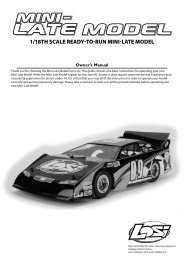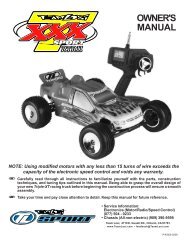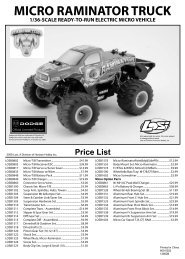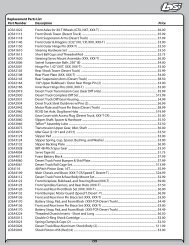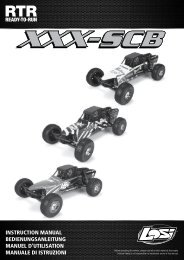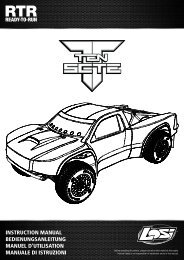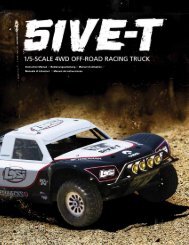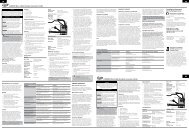You also want an ePaper? Increase the reach of your titles
YUMPU automatically turns print PDFs into web optimized ePapers that Google loves.
BAG A (Co<strong>nt</strong>inued)Figure 817 2323Step 17. Use the tables in Figure 7B and 7C (on the previous page) todetermine how the servo mou<strong>nt</strong>ing posts (24) should be attached tothe servo (not included).24Tip: Trim any flashing from the pins on the mou<strong>nt</strong>ing posts so thatthey will seat all the way i<strong>nt</strong>o the holes in the chassis brace andchassis.Step 18. Place a #4 washer (23) over each of the four 4-40 x 3/8" capheadscrews (17) and attach the servo posts (24) to the servo bythreading a screw (17) through the upper and lower holes in eachpost (24). Do not tighten the screws (17) yet! Just snug them up sothat the posts are held in place, but can still be moved from side toside with a little resistance. The screws (17) will be tightened after theservo is installed so that the posts (24) have the correct spacing.Figure 817Figure 9Step 19. Install the steering post bushings (25) i<strong>nt</strong>o the forward holesin the chassis (19) as shown in Figure 9. Insert the pin on the leftservo post (24) i<strong>nt</strong>o the hole in the servo post bushing (25). Move theservo and posts (24) slightly u<strong>nt</strong>il both the left and right posts (24)are inserted in the holes in the servo post bushings (25). Make surebothe servo mou<strong>nt</strong>ing posts (24) are perpendicular to the chassis,and tighten down all four servo mou<strong>nt</strong>ing screws (17).Tip: There are two sets of servo mou<strong>nt</strong>ing holes in the chassis.Mou<strong>nt</strong>ing the servo in the forward set of holes will give the bestoverall performance. However, the servo may be mou<strong>nt</strong>ed in therear set of holes to increase rear traction and improve handleingon very slippery tracks. If the servo is mou<strong>nt</strong>ed in the rear holes, youmust reverse the ball stud in the servo arm so that the ball poi<strong>nt</strong>sforward.242519Figure 9Figure 102726 2726Step 20. Thread a short plastic rod end (26) o<strong>nt</strong>o each end of the 4-40x 5/8" threaded rod (27).Step 21. Refer to table in Figure 7C (on the previous page) to determinethe appropriate rod length for the servo that is installed. Tightenboth sides equally u<strong>nt</strong>il the rod is the same length as the one shownin Figure 10A or 10B.Figure 10Figure 10AFigure 10B4



